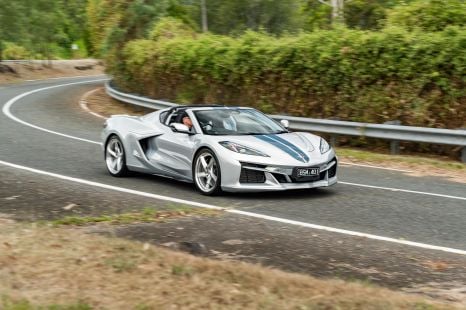

CarExpert.com.au
The CarExpert team's favourite cars of 2025
4 Days Ago
Toyota has brought some variety to the burgeoning light SUV segment, offering its new Yaris Cross with both all-wheel drive and a hybrid powertrain.
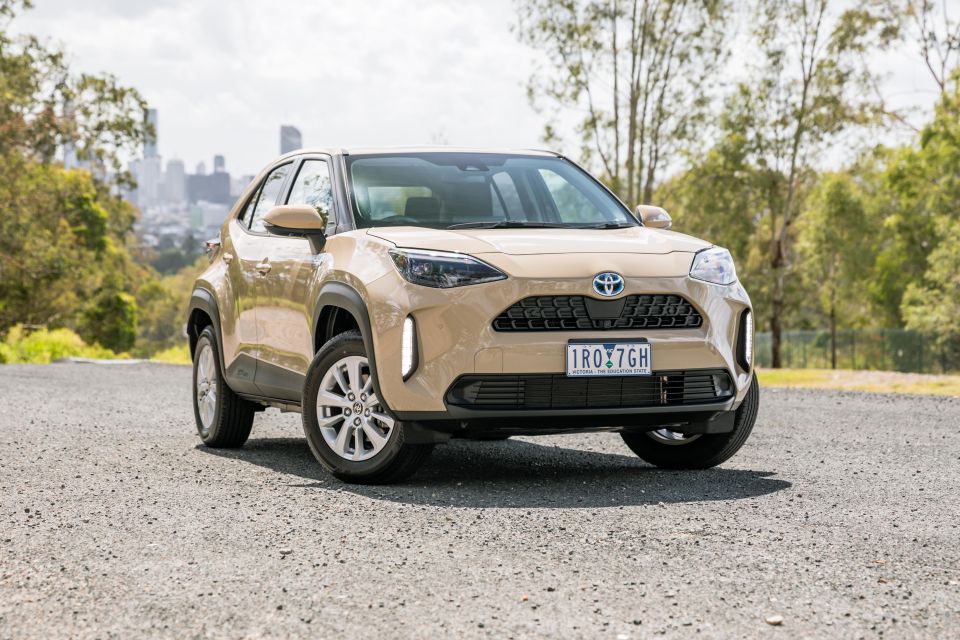
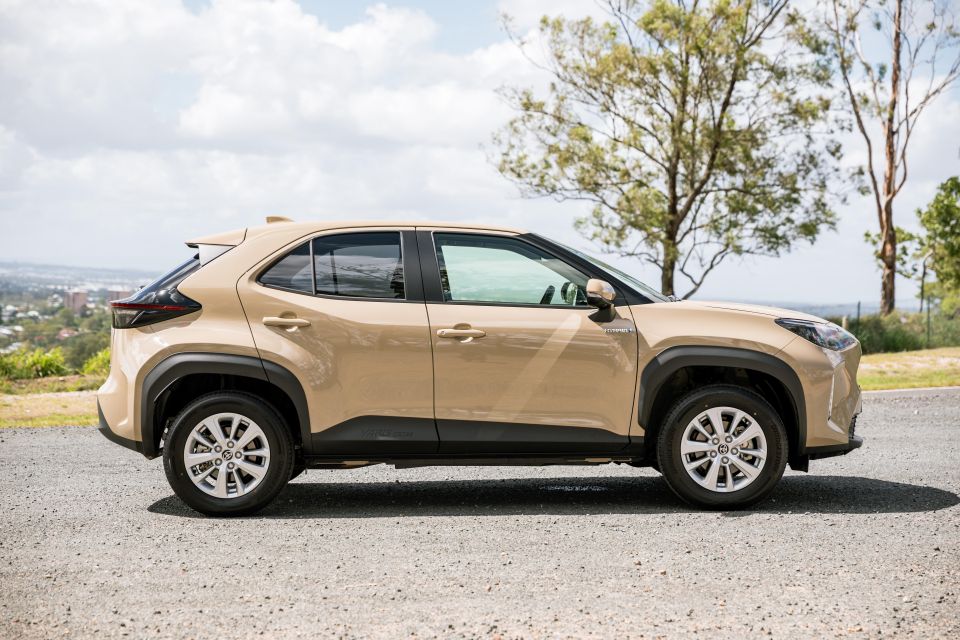

News Editor
New from
$26,990
excl. on-roads

News Editor
New from
$26,990
excl. on-roads


News Editor
New from
$26,990
excl. on-roads

News Editor
New from
$26,990
excl. on-roads
Quickly see how this car stacks up against its competition. Select any benchmark to see more details.
Where expert car reviews meet expert car buying – CarExpert gives you trusted advice, personalised service and real savings on your next new car.
The Toyota Yaris Cross has only been on the market a few months and I’m almost resigned to the fact it’ll overtake its rivals to become Australia’s best-selling light SUV.
After all, that’s the Toyota way. The brand has far and away the highest market share of any brand in Australia and its models typically top the sales charts in their respective segments – see Corolla, Camry, RAV4, LandCruiser Prado et all.
It’s off to a strong start, with its 541 sales in January placing it only behind the Mazda CX-3. And like many of Toyota’s best sellers, it offers a segment-exclusive hybrid powertrain. That’s good news for the Yaris Cross considering the recent dramatic uptick in hybrid sales locally, driven almost entirely by Toyota.

With its early sales success, the Yaris Cross has already avoided the ignominy of being one of Toyota’s rare sales misfires like the Fortuner or the old Rukus. It’s also doing better, comparatively, than the C-HR one segment above.
Unlike the garish, coupe-esque C-HR, the Yaris Cross has a boxier, more upright body that bears a strong familial resemblance to its Yaris hatchback namesake. But it’s stylistically a bit of an odd duck, not helped by our tester’s Latte paint colour which is more orthotic sandal beige than brown.
This is definitely a car that looks better in darker colours and with the 18-inch alloy wheels of the top-spec Urban. The GXL’s 16-inch alloy wheels look lost in the giant wheel arches, while the front arches extend higher than the rear ones. And it might be the pareidolia talking but it has a bit of a blasé face.
Underpinned by the same TNGA-B architecture as the controversially-priced Yaris, the Yaris Cross has the building blocks of a competitive entry into the burgeoning light SUV segment. But does it have more than just a large dealership network and an optional hybrid powertrain in its favour?
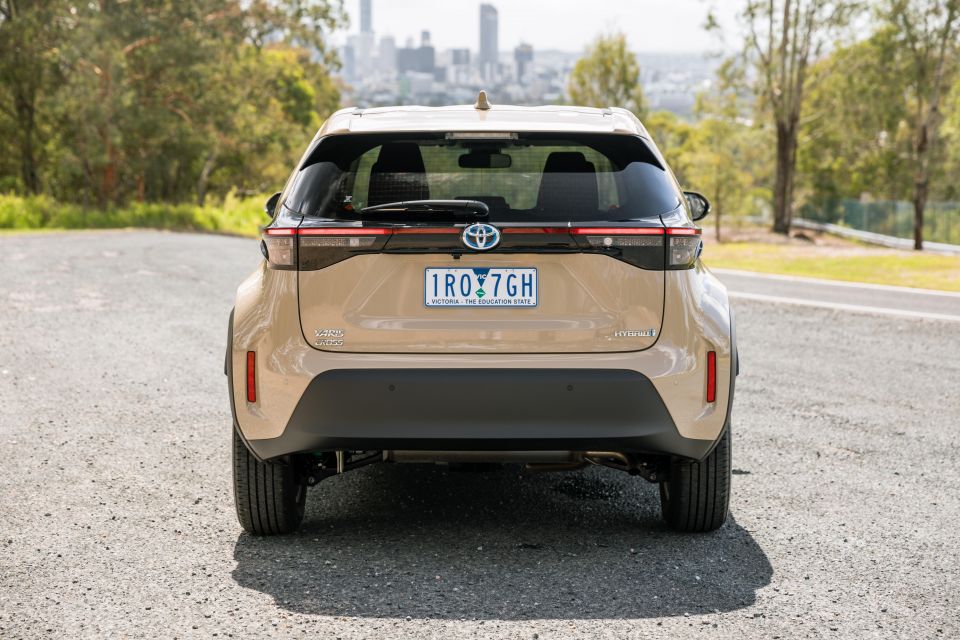
Toyota offers nine different Yaris Cross variants, with a choice of two powertrains and two drive types.
Our tester was the all-wheel drive GXL Hybrid, priced at $34,990 before on-road costs.
The GXL is the mid-range Yaris Cross, and in hybrid AWD guise costs the same as the range-topping Urban hybrid in front-wheel drive guise.
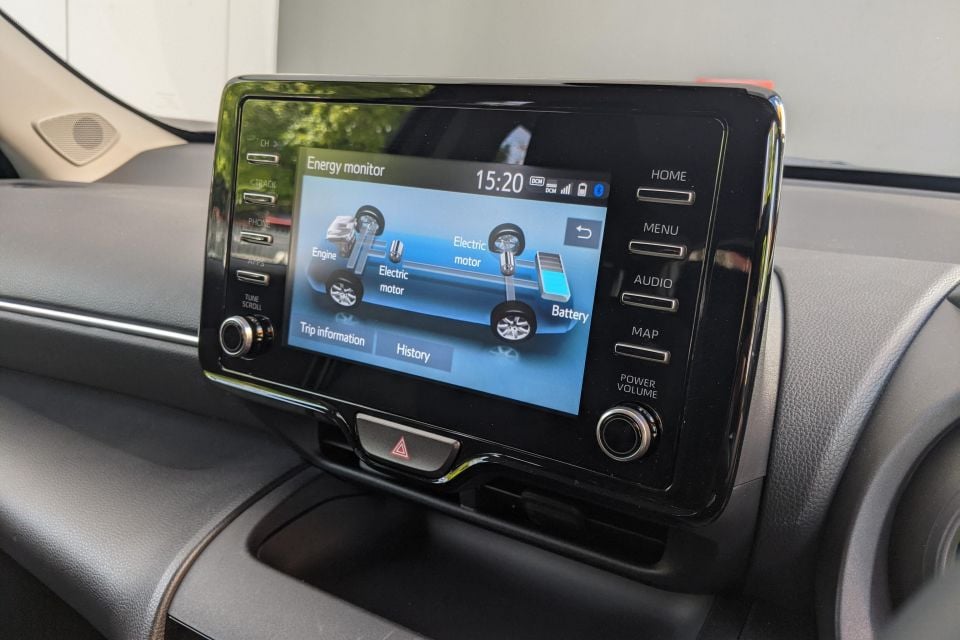
Buy your new car without the stress. It's fast, simple and completely free.

Great service from Travis and team, second time I have used this business would not hesitate to recommend them to anyone
Craig C.
Purchased a Ford Ranger in Sunshine Coast, QLD
CarExpert helped Craig save thousands on his Ford Ranger, now let us save you on your next new car.
Find a dealAll Yaris Cross models come standard with a 7.0-inch touchscreen infotainment system with DAB+ radio and wired Android Auto and Apple CarPlay, as well as single-zone climate control, a six-speaker sound system, as well as keyless entry and start.
Standard safety equipment across the range includes autonomous emergency braking with pedestrian and cyclist detection, front cross-traffic assist, emergency steering assist, lane-keeping assist and traffic sign recognition. Adaptive cruise control and automatic high-beam are also standard fit.
The Yaris Cross GX, therefore, has the fundamentals, but the GXL builds on that further with key inclusions like LED headlights, blind-spot monitoring, rear cross-traffic alert, a surround-view camera, and front and rear parking sensors. It also picks up satellite navigation.
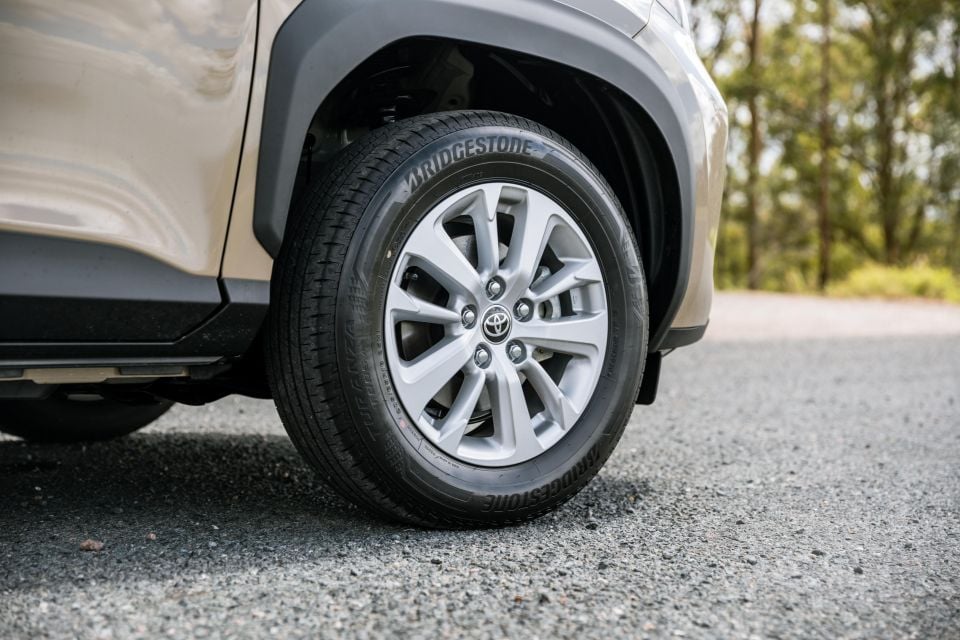
If you want some extra niceties, the Urban adds 18-inch alloys (up from 16 inches), a head-up display, power tailgate with kick sensor, along with power adjustment and heating for the driver’s seat. For our money, though, the GXL is the best value in the range.
Toyota isn’t the only game in town in the light and small SUV segments, however.
The Skoda Kamiq 85TSI auto is $7000 cheaper at $27,990 before on-road costs and also offers adaptive cruise control and keyless entry/start. Even after adding the $4100 Driver Support Pack to get semi-autonomous parking assist, blind-spot monitoring and rear cross-traffic alert, you’re still looking at a list price almost $3000 less than the Yaris Cross GXL Hybrid AWD, though you miss out on a surround-view camera and front parking sensors.
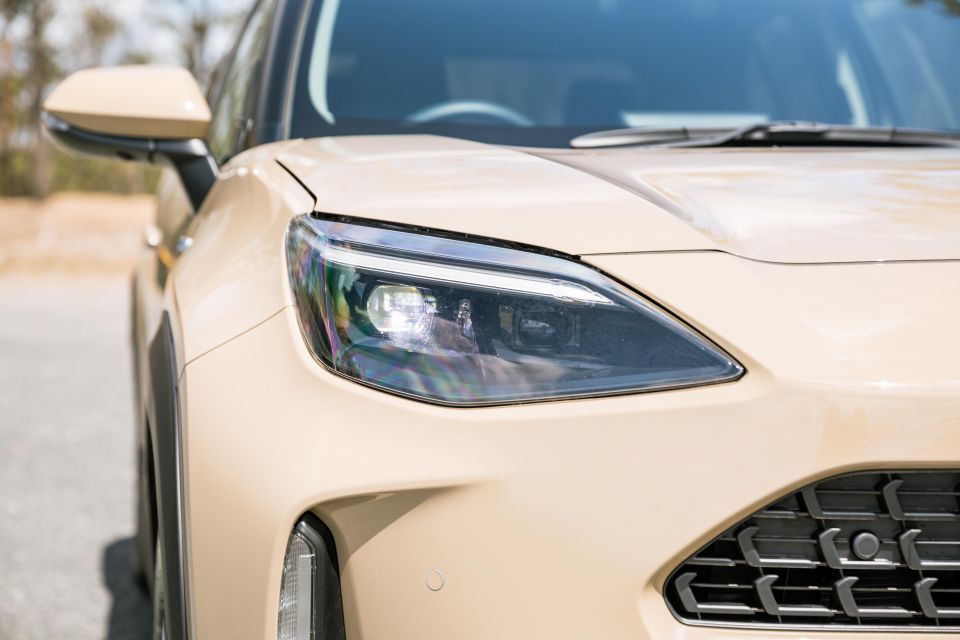
Its Volkswagen T-Cross cousin offers standard blind-spot monitoring, rear cross-traffic alert, adaptive cruise, keyless start, parking assist, LED headlights, and front and rear parking sensors in 85TSI Style guise, also undercutting the GXL Hybrid AWD at $31,390 before on-road costs. Add a $1500 option package to the base Ford Puma, priced from $29,990 list, and you’ll get the same kit.
There’s a segment wildcard, too, in the Hyundai Venue. It’s much cheaper than most rivals, even in range-topping Elite trim at $26,490 list. Its equipment list even in that grade is sparser than the Yaris Cross GXL’s, but it does include key safety features like blind-spot monitoring and rear cross-traffic alert, all for $8500 less.
Go up a segment – and to most, the distinction between light and small SUVs is purely academic – and there are still rivals that undercut the Toyota. The base MG ZST Excite, for example, has key features like a surround-view camera, blind-spot monitoring, rear cross-traffic alert, and adaptive cruise control. The price? $28,490 before on-roads.
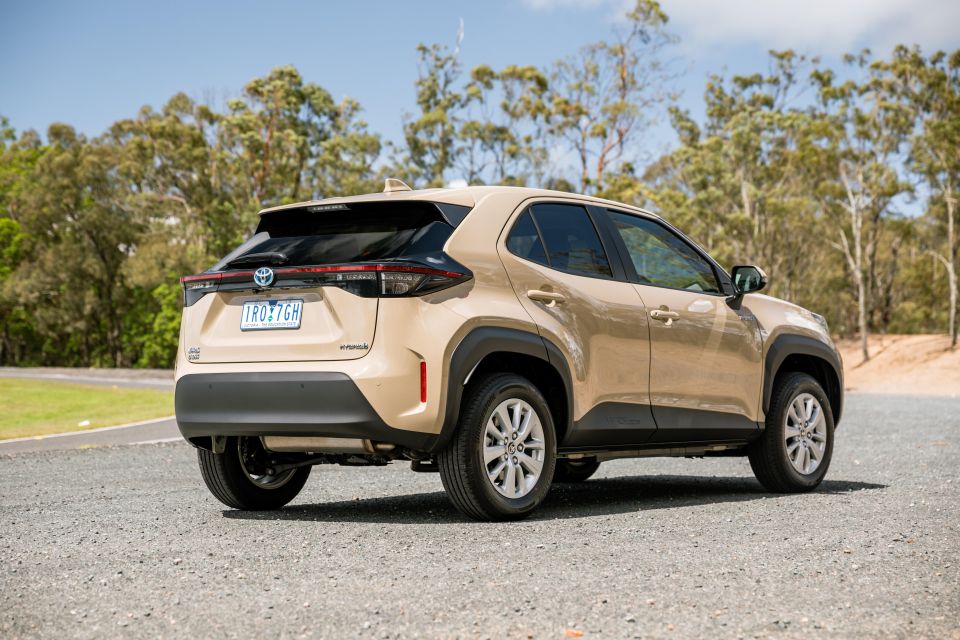
Other small SUVs that line up well with the Yaris Cross GXL in features include the Mazda CX-30 G20 Evolve ($31,490 list), Kia Seltos Sport+ ($32,790 list), Hyundai Kona Elite ($31,600 list), and even Toyota’s own C-HR GXL AWD ($32,915 list).
None of these models offer all-wheel drive at the same price point as the Yaris Cross, though, except for the C-HR.
In all, the Yaris Cross GXL is pricier than many key rivals but it offers a lot of kit as standard, including some features like a surround-view camera that are hard to find in this part of the market. A hybrid powertrain remains a rarity in this segment, while most of its rivals lack all-wheel drive or reserve it for pricier variants.
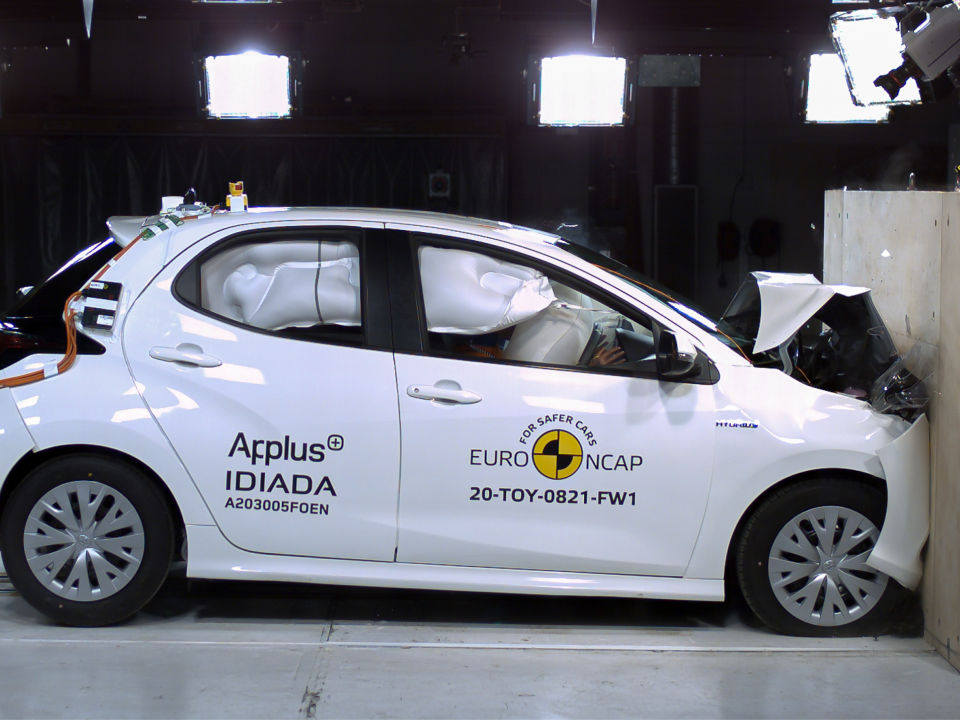
The Yaris Cross hasn’t been tested by ANCAP or Euro NCAP yet, but the Yaris hatch upon which it’s based (above) earned a five-star rating last year.
In addition to the aforementioned active safety equipment, there are eight airbags including the same centre airbag debuted in the Yaris hatchback.
The Yaris Cross is the first Toyota to automatically dial emergency services and relay your location in an accident thanks to Toyota Connected Services, which is reliant on a SIM card.
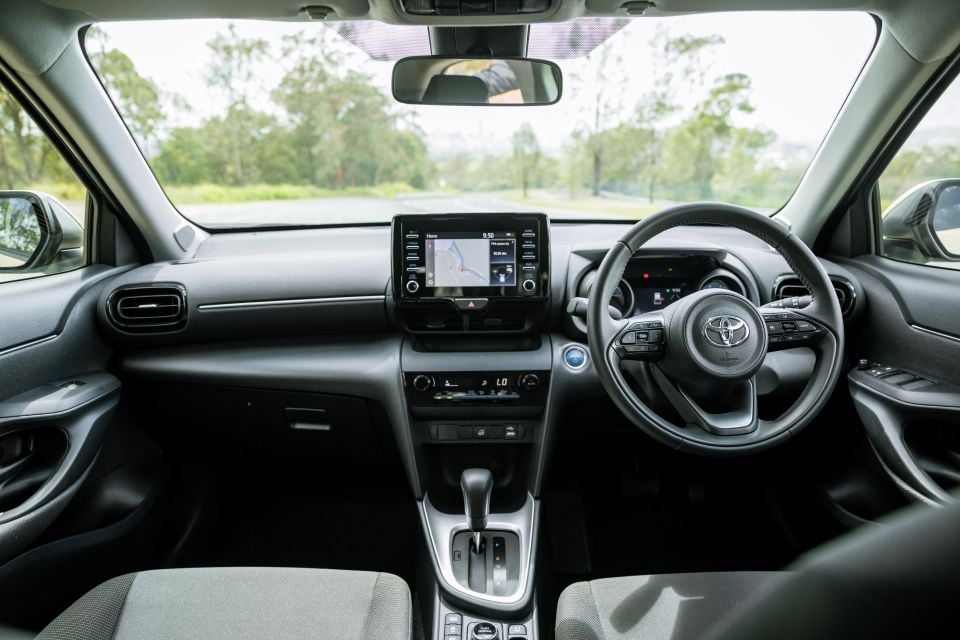
Toyota has effectively lifted and shifted the Yaris’ interior into the Yaris Cross. That’s both good and bad.
The good news is the overall interior design of both cars is fresh and modern. There’s a funky, two-tier look to the dashboard, while the touchscreen juts out from the dash as is so common nowadays.
There’s also a digital instrument cluster, with two pod-type gauges flanking a central screen. Likewise, the Toyota parts-bin climate controls are attractive in appearance and functional to use.
There’s a swathe of nice, soft-touch material across the dash top but that’s all you’ll find. Hard plastics aren’t unusual in this segment – just look at the Volkswagen T-Cross – but there are some disappointing material choices.
We like that the front door trims aren’t just plastic on plastic, but we don’t love the mouse fur-type trim they’ve used either. Call us fussy. The headliner also feels low-rent.
There are some strange design choices, too. Rather than looking like a tablet stuck to the dash – like on an Audi A4, for example – the touchscreen manages to look like that from the front but have a weird moulding behind it.
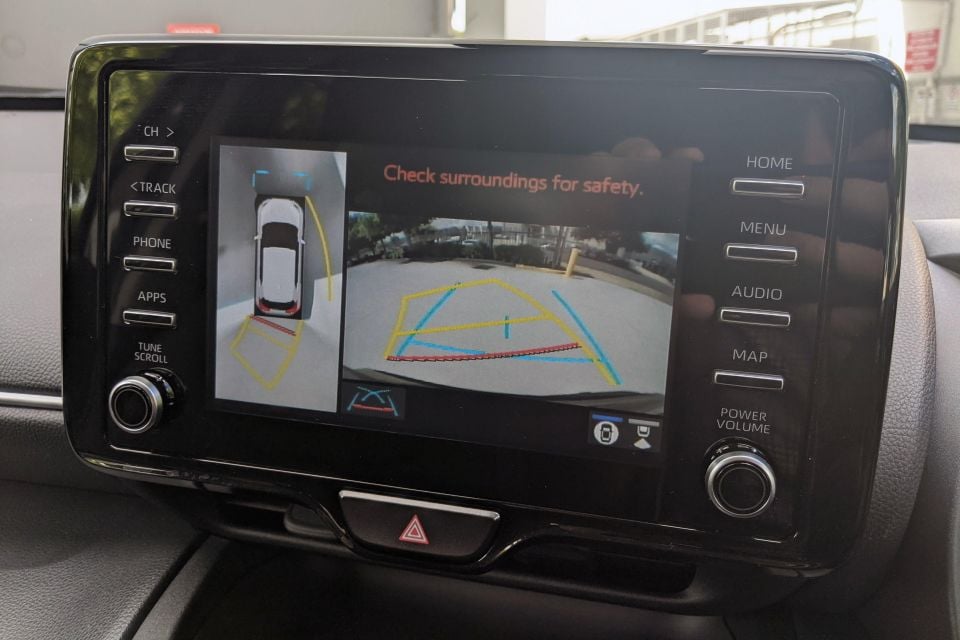
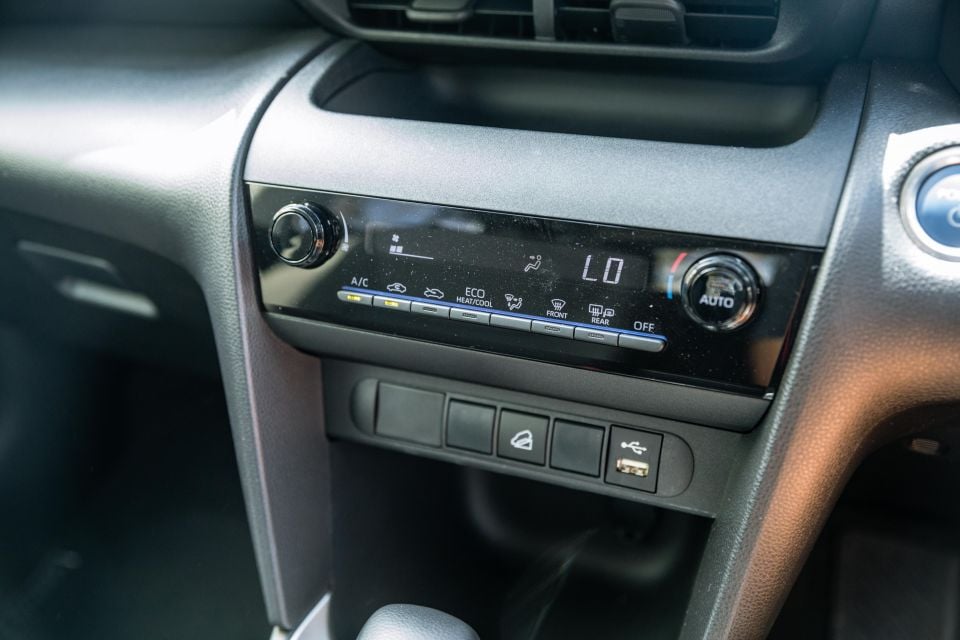
The shifter and its surrounds look straight out of the 1990s. Call me crazy, but our tester even smelled like the old HiLux utes my father drove for work in the 1990s.
There are also a surprising number of button blanks on the dashboard for a mid-range car. One large blank covers where you’d find an additional USB outlet in the Urban, which begs the question as to why Toyota would bother to remove that in the GXL. That leaves a single USB outlet on the centre stack, along with a 12V outlet.
Even from a practical point of view, the two trays at the centre and base of the centre stack don’t have any kind of rubberised material in them to keep your phone from sliding around.
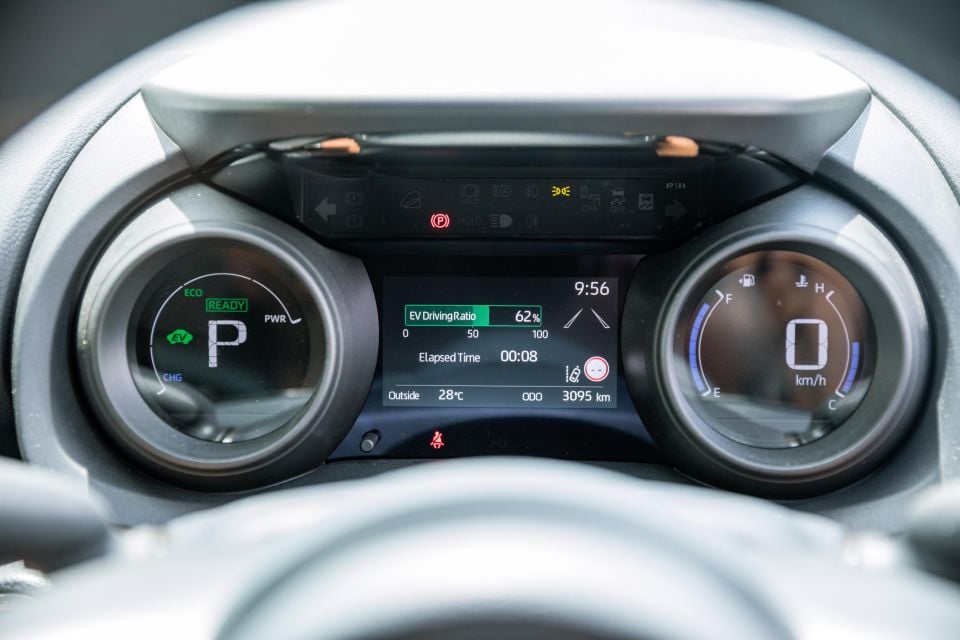
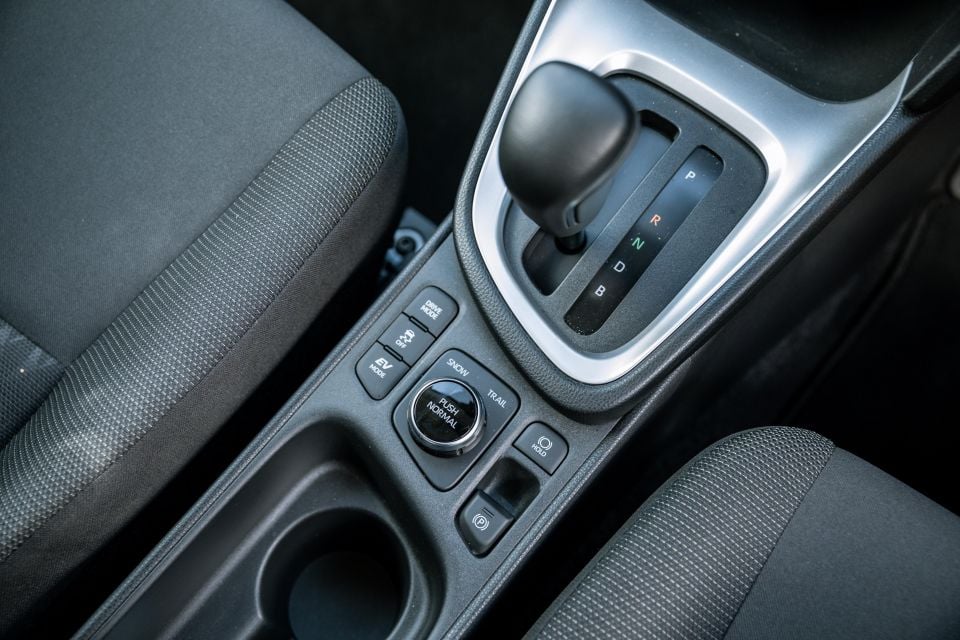
The lack of a centre console bin or armrest is an utterly skinflint move by Toyota. Where at the very least a small covered bin would sit in a rival, you’ll instead find a small, open recess. You can’t rest your elbow on it and you can’t conceal anything in it.
As for the cute gauges, they’re lovely and legible until you get some sunlight on them. Then, they’re hard to read through the glare.
The inclusion of a surround-view camera, even in a car this small, is absolutely welcome as few rivals offer one. But the picture quality of that camera view, as well as the reversing camera, is extremely grainy and low-resolution.
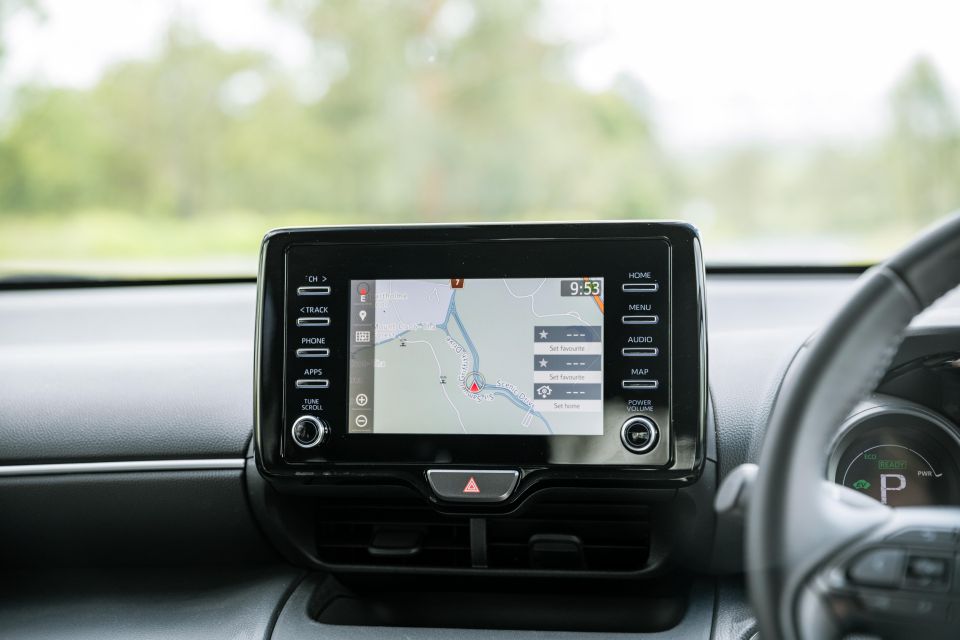
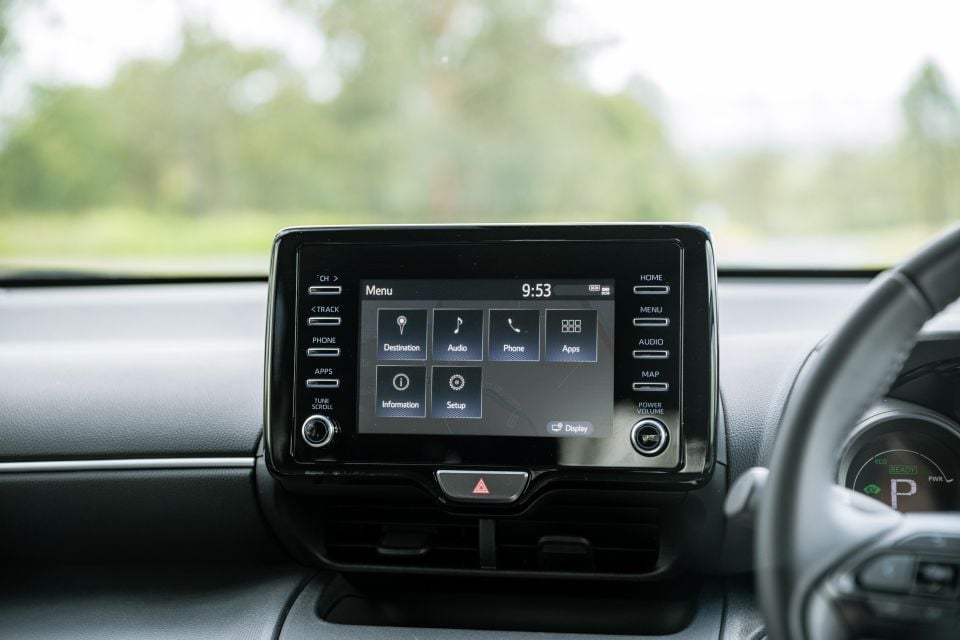
The user interface on Toyota’s infotainment systems is looking a bit dated now against rival automakers’, including Kia, but it’s still quite easy to navigate and helpfully surrounded by hard shortcut buttons.
We also appreciate the inclusion of a screen that shows how the power is being distributed throughout the petrol-electric hybrid system.
The screen is a bit small, though. Seven inches used to be enough but now we want more – eight inches is the norm, now, while some rivals offer screens as large as 10.25 inches.
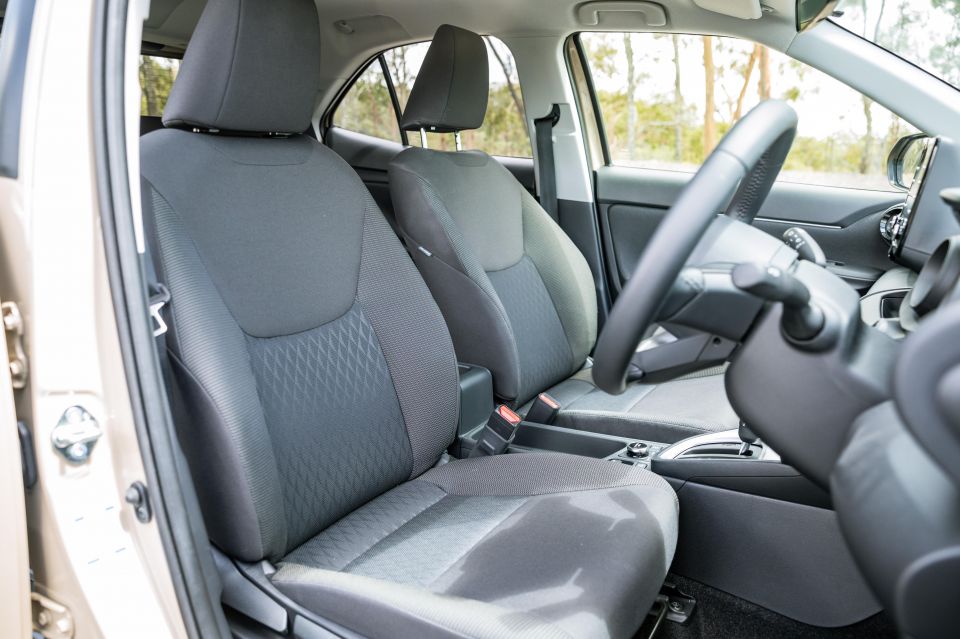

Moving to the rear, there’s sufficient headroom and knee room for someone around 180cm tall sitting behind a similarly-sized driver, while visibility is superior to a C-HR.
There are no rear air vents, though there’s a single map pocket on the passenger side plus bottle holders in the doors which, like those up front, can accommodate a 1L bottle. The rear doors feel quite light and the door cards are entirely plastic, though the seatbacks are upholstered.
Child seats can be installed using one of the three top-tether or two ISOFIX anchor points.
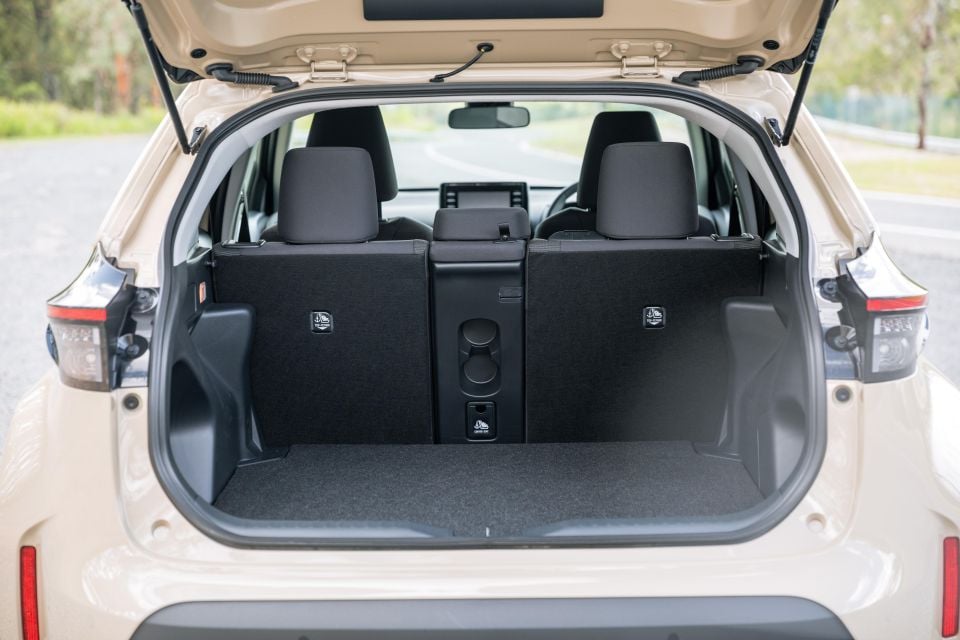
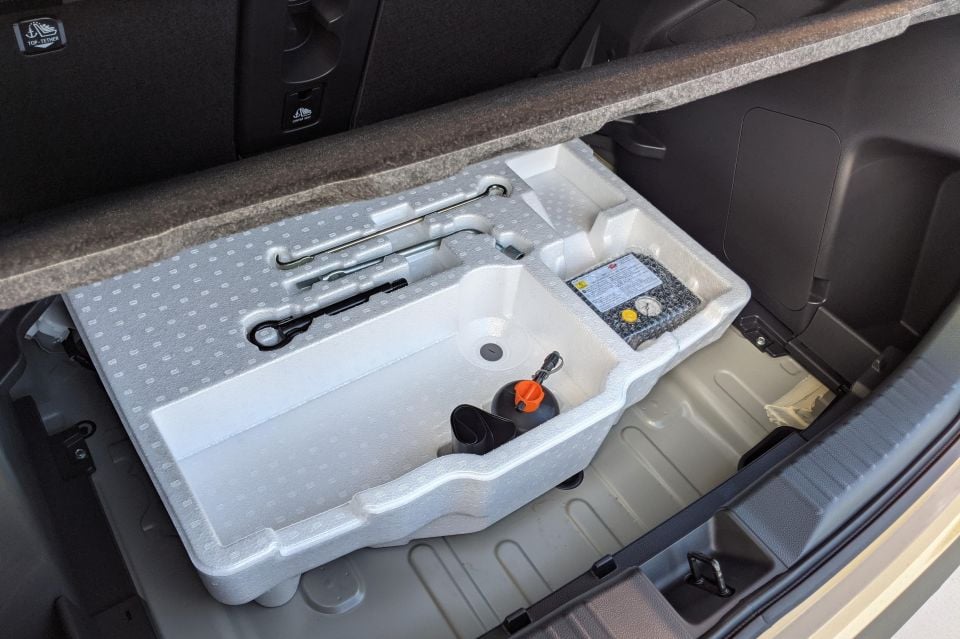
Where expert car reviews meet expert car buying – CarExpert gives you trusted advice, personalised service and real savings on your next new car.
The all-wheel drive hybrid Yaris Cross, which uses a multi-link rear suspension, has less luggage space than the front-wheel drive models with their torsion-beam rear suspension.
VDA cargo capacity shrinks from 390L to 314L, and Toyota has also nixed the space-saver spare of the FWD models for a tyre repair kit despite the under-floor area looking large enough for a spare.
At 314L, it has one of the smallest capacity load bays in the segment though it bests the Mazda CX-3’s titchy 264L boot. It’s also just 4L down from the larger C-HR, though rivals like the Skoda Kamiq (400L) and Ford Puma (410L) offer far more.
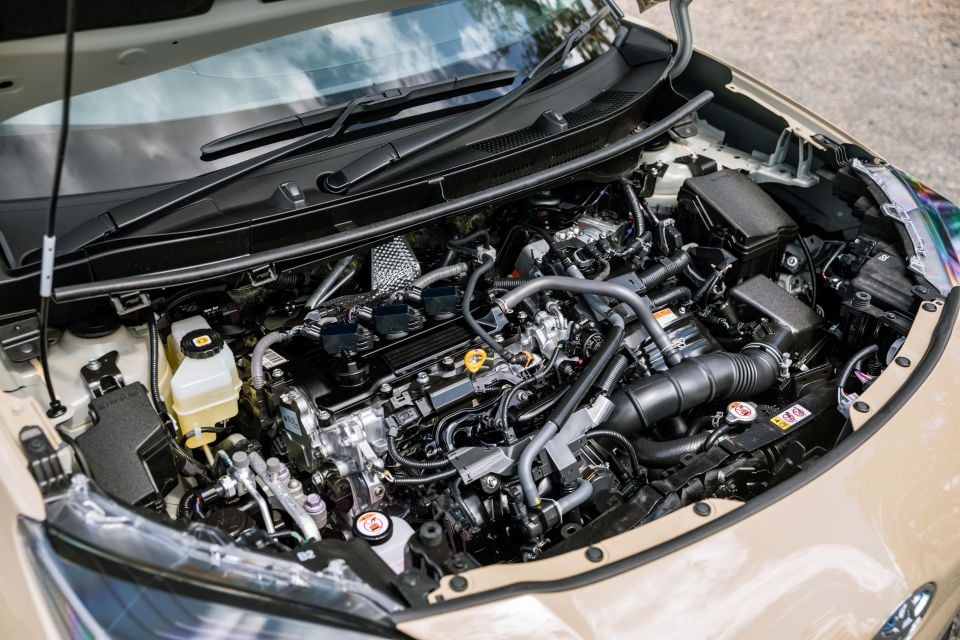
The Yaris Cross range consists of three powertrains. All feature a 1.5-litre three-cylinder engine mated to a continuously-variable transmission, with hybrid models adding two electric motors and the all-wheel drive model adding a third on the rear axle.
Despite the additional motor, power output is the same as the two-wheel drive hybrid: 85kW.
No total torque figure is provided, though the internal combustion engine alone outputs 67kW of power and 120Nm of torque.
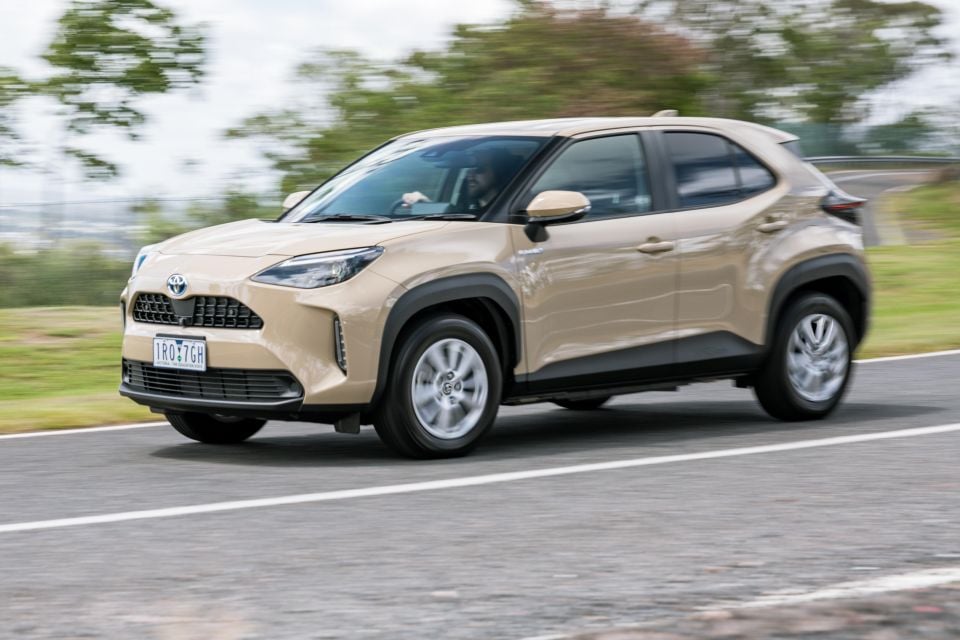
Toyota’s new TNGA-based vehicles may have proved more dynamically adept than last-generation Toyotas but the Yaris Cross is still rather disappointing to drive, though that’s not to say it’s dramatically worse than key rivals.
While its titchy dimensions make it feel nimble, the Yaris Cross simply isn’t a fun steer. We mean that quite literally, as the steering feels numb on centre though it’s helpfully light for urban manoeuvring.
The handling is largely par for the course for this segment. Like a T-Cross, you can feel the higher centre of gravity than in a conventional light car, while body roll is keenly felt in corners and changes in direction are punctuated by understeer.
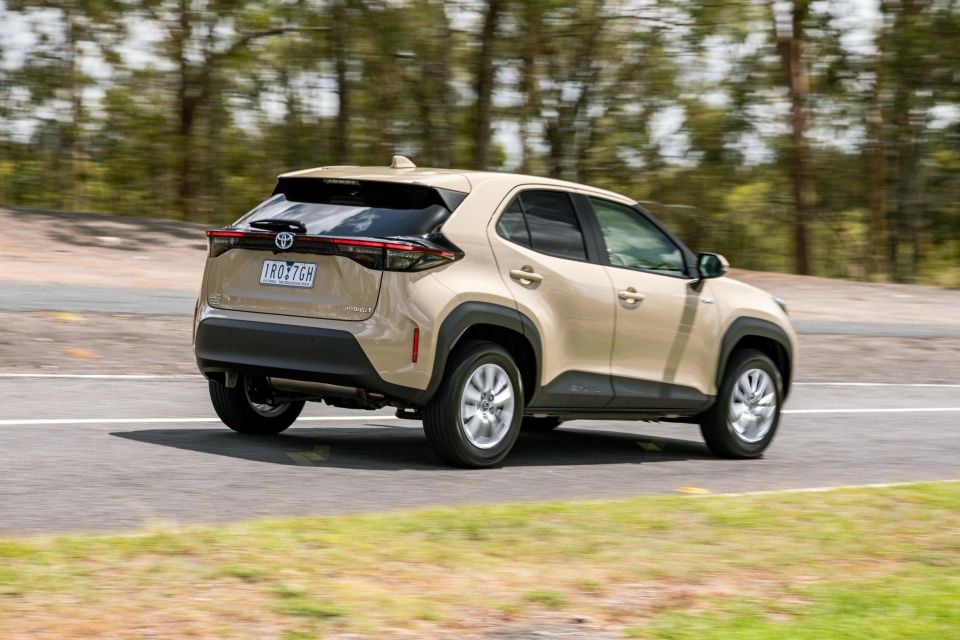
We enjoy those moments of serenity where the Yaris Cross is in EV mode at speeds below 20km/h, because once the petrol motor kicks in it sounds rather gravelly. It’s not too obtrusive except for uphill climbs where the engine has to work its hardest and, consequently, sounds like an overheating refrigerator.
Three-pot engines can be a little coarse, though they often compensate by having a charming, thrummy engine note – see the T-Cross or Kamiq, for example. But mating a three-cylinder engine with a CVT is like running your blender while you’re mowing the lawn.
At least the CVT helps keep the Yaris Cross feeling relatively sprightly on the road. It’s no rocketship but it has enough power to get out of its own way, including in overtaking manoeuvres.
Ride quality in the Yaris Cross is so-so. Despite the all-wheel drive model using a more sophisticated multi-link rear suspension, the Yaris Cross has a tendency to thud over bumps. You can feel every expansion joint, while the ride quality is generally quite busy.
In that respect, it’s rather like a Juke although the Nissan has an ace up its sleeve in its more enjoyable handling. Make no mistake, the Yaris Cross doesn’t buck and heave like an old-school four-wheel drive but nor does it ride quite as smoothly as the likes of the T-Cross. We found the brake pedal felt a bit spongy, too.
As with other hybrid Toyotas, there’s a B mode you can move the shifter to that applies moderate engine braking going down hills.
The lane-keeping assist isn’t the most assertive of systems but the lane-tracing assist, operational when you’ve turned on the adaptive cruise control, does an admirable job keeping the car within its lane.
One final note: on the road, our tester suffered from an occasional rattle coming from somewhere in the rear of the cabin.
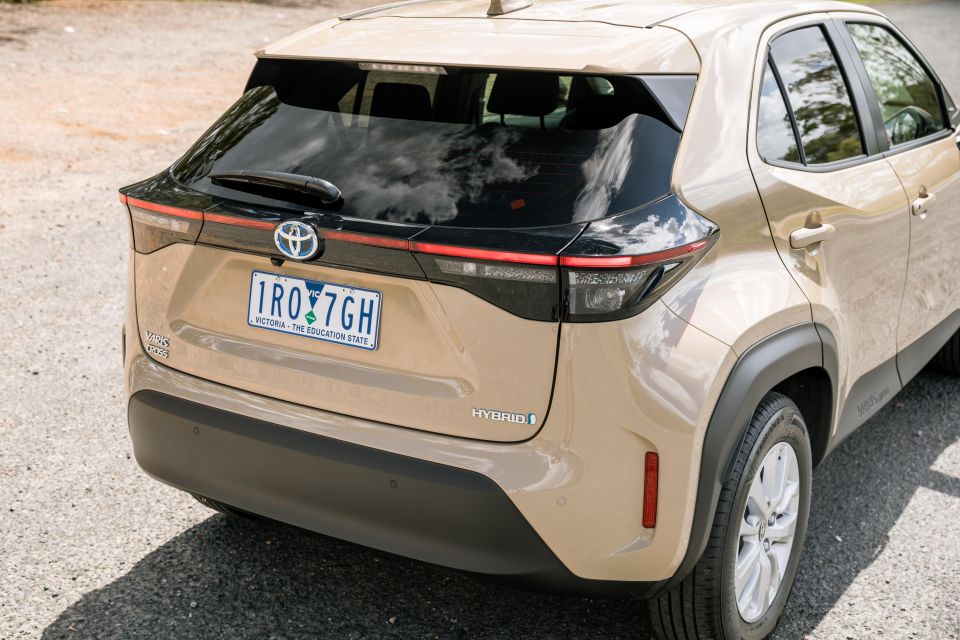
Perhaps the most endearing aspect of the Yaris Cross is its fuel economy. Quite simply, it’s superb. Over our test loop, comprising inner-city, suburban and highway roads, we averaged just 4.3L/100km against an ADR combined cycle rating of 4.0L/100km.
Even after a week of driving, we were still averaging 4.5L/100km. It runs on 91 RON regular unleaded, too, while fuel tank capacity is 36L.
As with the wider Toyota range, the Yaris Cross is backed a five-year, unlimited-kilometre warranty.
The first five services are priced at $205 each under Toyota’s capped-price service scheme, making it one of the cheapest cars to service in this segment. Intervals are 12 months or 15,000 kilometres, whichever comes first.
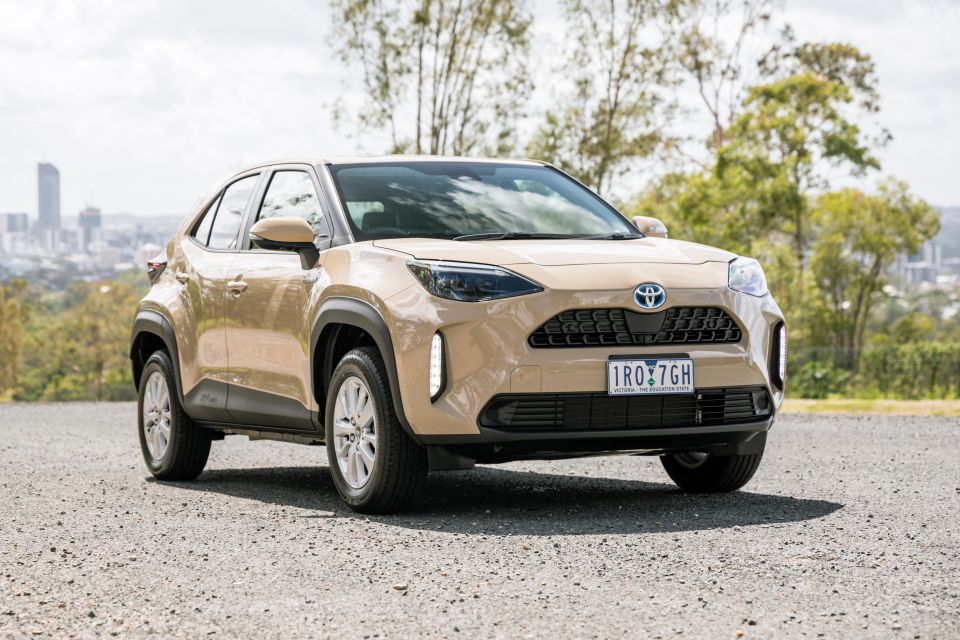
The Toyota Yaris Cross feels built to a price. Unfortunately, that price isn’t $34,990 before on-roads.
It doesn’t help that the light and small SUV segments it’s competing in are absolutely booming, giving Australian buyers an abundance of options.
The Skoda Kamiq 85TSI, for example, has a smoother, more willing powertrain and a much nicer interior while still offering exceptional fuel economy.
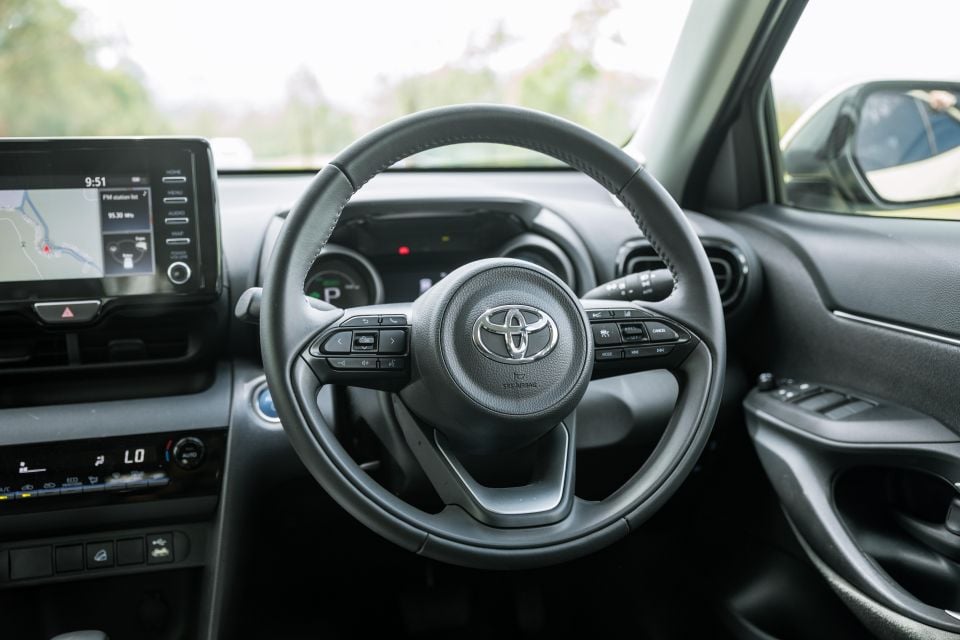
You pay the “SUV tax” with the Yaris Cross, but at least it offers all-wheel drive unlike many of its light car-based competitors and offers the segment’s only hybrid.
Alas, there’s no wow factor in the Yaris Cross, apart from its stellar fuel economy. It’s not especially fun-to-drive and it doesn’t have the nicest interior or sharpest price in its class.
In a way, then, it’s a classic, old-school Toyota – it’s not necessarily a class-leader but it’s put together well, it’s bound to be reliable, its resale value will likely hold up, and it’s an entirely sensible option.
Unless you really want the extra traction of all-wheel drive, however, save $3000 and go for the front-wheel drive GXL hybrid.
Click the images for the full gallery
MORE: Toyota Yaris Cross news, reviews, comparisons and videos
Where expert car reviews meet expert car buying – CarExpert gives you trusted advice, personalised service and real savings on your next new car.
William Stopford is an automotive journalist with a passion for mainstream cars, automotive history and overseas auto markets.


CarExpert.com.au
4 Days Ago
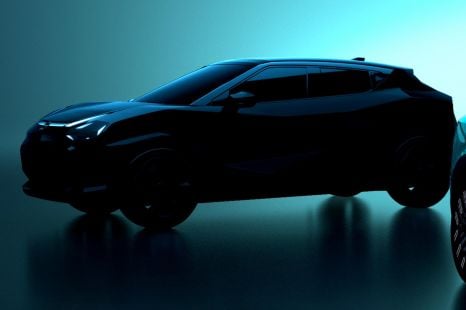

Damion Smy
4 Days Ago
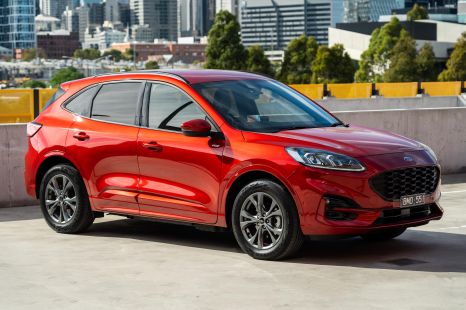

Damion Smy
5 Days Ago
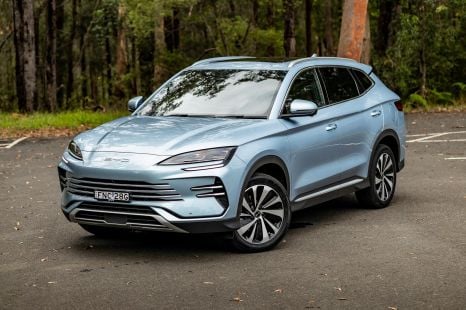

Josh Nevett
5 Days Ago


Max Davies
5 Days Ago


Ben Zachariah
6 Days Ago